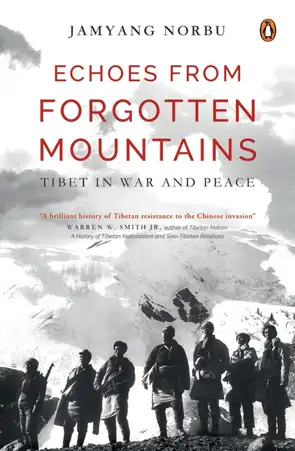[Palden Sonam]
Jamyang Norbu’s new book, Echoes From Forgotten Mountains: Tibet in War and Peace, is a tapestry of history, memoir, autobiography and politics told by someone who was not only a keen observer but also a direct participant in some of the major events covered in the book.
Fascinating, erudite, profound and tragic, it is a comprehensive chronicle of the modern history of Tibet – the decades of Chinese invasion and occupation of Tibet and Tibetan resistance and life and struggle in exile. The shift in narratives from the personal to political, triumph to tragedy, historical to anecdotal and memory songs to guerrilla operation highlights the author’s intimate connections as well as intellectual interests and investment in the stories featured in the book – making it a work of tour de force with great breadth and depth. The author wrote, “I have spent a considerable period of my life interviewing people for their personal stories.” The author’s proclivity for stories of people from different backgrounds and his skill in weaving them into a cohesive and compelling national narrative make the book stand out from similar works on Tibet.
It is also an inerasable history and a stainless tribute to those Tibetan men and women whose courage and commitment for the freedom of their country laid the foundation for the resistance movement and continues to inspire new generations of Tibetans in their national cause.
As the author wrote, “No matter how outnumbered or powerless, they had done something about their fate. They had not accommodated themselves to their oppressor. They had not allowed themselves to be led tamely like sheep to the labour camps or the execution grounds. The extraordinary stories of sacrifices and resilience of many ordinary people who had to weather through extremely difficult periods in their national as well as personal life -occupation, war, uprising, famine, imprisonment, labour camp, and exile -issues still recurring and relevant in today’s world from Ukraine to Gaza – help to understand these issues and draw lessons and inspiration.
Speaking of occupation and resistance, this book is a great intellectual contribution to resist against China’s persistent, and often intrusive, effort to erase the very idea and history of Tibet as an independent nation and a distinct civilisation from China. The erasure and/or falsification of history for a political end is sinister and serious in China occupied Tibet where history is falsified for the political interest of a regime that is not only dictatorial but also colonial. This distortion of history includes the spinning of recent events like China’s military occupation of Tibet as ‘peaceful liberation’ and violent dismantling of traditional Tibetan social system as ‘democratic reform’ to list but few. In this context, this book is a historical and intellectual bulwark against the distortion of history and forced amnesia.
Moreover, Norbu has done a fantastic job by bringing to the fore stories of many ordinary but unsung heroes and heroines – particularly the women warriors like Dorje Yudon, of Nyarong, and the Buddhist nun, Ani Trinlay Chödön, of Nyenmo, who led armed rebellion against Chinese rule. Or the story of Bhusang, a farmer who fought with the invading Chinese forces in Lhasa, later got captured and spent 18 years in Chinese jail and labour camp -still survived to tell his story in his own words.
The history of Tibetan armed resistance has not received the recognition and interest it deserved even in Tibetan community in exile as the Tibetan government-in-exile opted for a nonviolent approach to solve the Sino-Tibetan conflict and Tibetan stories of guerrilla operations are seen as not so comfortable facts that better be left in the past. Norbu joined the Tibetan guerrilla operation in Mustang in the early 1970s with a bag full of books – maybe anunusual thing for a guerrilla fighter. However, it seems he believed both in the power of the pen as well as the necessity of the sword, if a situation so demands. In this book he tells the story of his comrades in arms.
A great addition to the book is the informative and easy to read maps indicating Chinese advancing lines, major battlegrounds, and location of Tibetan and Chinese military bases. It also has maps of important places and routes related to Tibetan resistance army’s operation such as Gonpo Tashi’s long north ride in Tibet, Kalimpong and Darjeeling in India and Mustang in Nepal.
Another valuable addition is the rare photographs of important and interesting people – ministers, generals, scholars, soldiers, international spies, and prisoners – as well as scenes of struggle sessions, executions and important meetings. The inclusion of maps and photographs not only add to the archival richness of the work but also situating the major events in their geographical and strategic locales and the pictures give a real sense of the people involved in those events playing different roles. The ability to point where an event took place decades ago and see the images of actors behind these events brings one closer to the actual events. In that sense, the maps and photographs help to reduce the gap between the textual and contextual by bridging the geographical and temporal differences.
Thanks to the author’s expertise and skill as a veteran political commentator, many of the issues and events in the book are explained and analysed in the larger context of international geopolitics during the Cold War period, which makes it easier for ageneral reader to understand not just what happened in Tibet or with the Tibetans, but also how and why what happened had happened.
This book, in the ultimate analysis, is an emphatic refusal of an occupied nation to be erased, silenced and forgotten into an irrelevant oblivion. Each echo from forgotten mountains is singing, speaking and roaring to be read and heard. (The contributor is a Delhi-based independent researcher)



